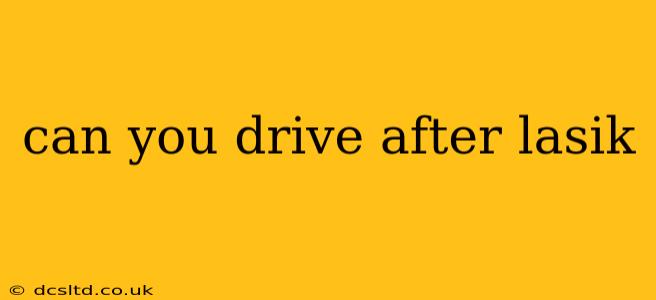Can You Drive After LASIK? A Comprehensive Guide
LASIK surgery offers the exciting prospect of clearer vision and freedom from glasses or contact lenses. But a crucial question many prospective patients have is: can I drive after LASIK? The short answer is: it depends. While many people can drive home after LASIK, it's not universally recommended, and the decision should be made carefully based on individual circumstances and your surgeon's advice.
This guide will delve into the factors that influence your ability to drive after LASIK, addressing common concerns and providing clear guidance.
What Affects My Ability to Drive After LASIK?
Several factors determine when you can safely resume driving after LASIK:
-
Individual Response to Anesthesia: The type and amount of anesthetic used during the procedure can influence your recovery time. Some individuals experience drowsiness or lightheadedness post-surgery, making driving unsafe.
-
Pain Medication: If you're prescribed pain medication, it's crucial to understand its potential side effects, including drowsiness and impaired coordination. Driving while under the influence of such medication is illegal and dangerous.
-
Visual Acuity: Even if you feel fine, your vision might not be fully restored immediately after surgery. Temporary side effects such as blurry vision, glare, or halos can significantly impact your driving ability. Your surgeon will assess your visual acuity before determining if driving is safe.
-
Surgeon's Recommendations: Your ophthalmologist's post-operative instructions are paramount. They will assess your specific situation and advise you on when you can safely resume driving, considering your individual recovery progress and any complications. Always prioritize your surgeon's advice.
How Long Should I Wait Before Driving After LASIK?
There's no one-size-fits-all answer. While some patients might be able to drive home a few hours after surgery, others may need to wait a day or even longer. The typical recommendation is to avoid driving for at least several hours, or even overnight, allowing the anesthetic to wear off and your vision to stabilize.
What Are the Risks of Driving Too Soon After LASIK?
Driving after LASIK before your vision is fully restored and you are fully alert is extremely risky. You could experience:
- Blurred vision: This significantly impairs your ability to judge distances and react to unexpected events on the road.
- Glare or halos: These visual disturbances can make driving at night especially dangerous.
- Reduced reaction time: Drowsiness or the side effects of medication can slow your reflexes.
- Accidents: The combination of impaired vision and reduced alertness dramatically increases the risk of accidents.
What Should I Do If I'm Unsure if I Can Drive?
When in doubt, do not drive. Arrange for a friend or family member to pick you up, or use a ride-sharing service. Your safety and the safety of others on the road are far more important than the inconvenience of not driving immediately after surgery.
What Happens After the Surgery? What's the Recovery Like?
Following LASIK, your surgeon will provide detailed post-operative instructions, including medication, eye drop schedules, and follow-up appointments. You will likely experience some temporary side effects like dry eyes, itching, or mild discomfort. Your vision will gradually improve over several days or weeks.
In conclusion, while many people can drive home after LASIK, it's crucial to prioritize safety. Always follow your surgeon's instructions, and if you experience any visual disturbances or drowsiness, avoid driving until your vision is fully restored and you feel alert and safe behind the wheel. Your vision is precious—protect it.
